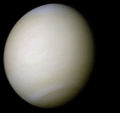.gif)
The Lotus Eaters (Weinbaum)
Encyclopedia
"The Lotus Eaters" is a science fiction
short story
by Stanley G. Weinbaum
originally published in the April 1935 issue of Astounding Stories. "The Lotus Eaters" was Weinbaum's fifth published story, and is a sequel to "Parasite Planet
".
 A month after the events in "Parasite Planet", Hamilton "Ham" Hammond and Patricia Burlingame are married, and thanks to Burlingame's connections, the two have been commissioned by the Royal Society
A month after the events in "Parasite Planet", Hamilton "Ham" Hammond and Patricia Burlingame are married, and thanks to Burlingame's connections, the two have been commissioned by the Royal Society
and the Smithsonian Institution
to explore the night side of Venus
. There they find a species of warm-blooded mobile plants with a communal intelligence that Burlingame nicknames Oscar. Oscar is very intelligent, quickly picking up English from Hammond and Burlingame.
The humans learn that the Oscar beings reproduce by releasing clear bubbles full of gaseous spores. When the bubbles burst, the spores come to rest on another Oscar being, eventually grow into another individual, and bud off. In “Parasite Planet”, the vicious, night-dwelling Triops noctivivans used these bubbles to attack Hammond and Burlingame, since the spores have a soporific effect on humans.
The humans are horrified to learn that, being plants, the Oscar beings have no survival instinct. Despite their greater-than-human intelligence, the Oscar beings react with indifference when the local trioptes attack and consume them. This prompts Burlingame to name their species Lotophagi veneris – the lotus eaters of Venus. Hammond and Burlingame barely escape the trioptes themselves after exposure to the spores leaves them almost catatonic.
Science fiction
Science fiction is a genre of fiction dealing with imaginary but more or less plausible content such as future settings, futuristic science and technology, space travel, aliens, and paranormal abilities...
short story
Short story
A short story is a work of fiction that is usually written in prose, often in narrative format. This format tends to be more pointed than longer works of fiction, such as novellas and novels. Short story definitions based on length differ somewhat, even among professional writers, in part because...
by Stanley G. Weinbaum
Stanley G. Weinbaum
Stanley Grauman Weinbaum was an American science fiction author. His career in science fiction was short but influential...
originally published in the April 1935 issue of Astounding Stories. "The Lotus Eaters" was Weinbaum's fifth published story, and is a sequel to "Parasite Planet
Parasite Planet
"Parasite Planet" is a science fiction short story by Stanley G. Weinbaum originally published in the February 1935 issue of Astounding Stories. It was Weinbaum's fourth published story, and the first to be set on Venus...
".
Plot summary

Royal Society
The Royal Society of London for Improving Natural Knowledge, known simply as the Royal Society, is a learned society for science, and is possibly the oldest such society in existence. Founded in November 1660, it was granted a Royal Charter by King Charles II as the "Royal Society of London"...
and the Smithsonian Institution
Smithsonian Institution
The Smithsonian Institution is an educational and research institute and associated museum complex, administered and funded by the government of the United States and by funds from its endowment, contributions, and profits from its retail operations, concessions, licensing activities, and magazines...
to explore the night side of Venus
Venus
Venus is the second planet from the Sun, orbiting it every 224.7 Earth days. The planet is named after Venus, the Roman goddess of love and beauty. After the Moon, it is the brightest natural object in the night sky, reaching an apparent magnitude of −4.6, bright enough to cast shadows...
. There they find a species of warm-blooded mobile plants with a communal intelligence that Burlingame nicknames Oscar. Oscar is very intelligent, quickly picking up English from Hammond and Burlingame.
The humans learn that the Oscar beings reproduce by releasing clear bubbles full of gaseous spores. When the bubbles burst, the spores come to rest on another Oscar being, eventually grow into another individual, and bud off. In “Parasite Planet”, the vicious, night-dwelling Triops noctivivans used these bubbles to attack Hammond and Burlingame, since the spores have a soporific effect on humans.
The humans are horrified to learn that, being plants, the Oscar beings have no survival instinct. Despite their greater-than-human intelligence, the Oscar beings react with indifference when the local trioptes attack and consume them. This prompts Burlingame to name their species Lotophagi veneris – the lotus eaters of Venus. Hammond and Burlingame barely escape the trioptes themselves after exposure to the spores leaves them almost catatonic.
Collections
"The Lotus Eaters" appears in the following Stanley G. Weinbaum collections:- The Dawn of Flame (1936)
- A Martian Odyssey and OthersA Martian Odyssey and OthersA Martian Odyssey and Others is a collection of science fiction short stories by author Stanley G. Weinbaum. It was first published in 1949 by Fantasy Press in an edition of 3,158 copies...
(1949) - A Martian Odyssey and Other Classics of Science Fiction (1962)
- A Martian Odyssey and Other Science Fiction Tales (1974)
- The Best of Stanley G. Weinbaum (1974)
- Interplanetary Odysseys (2006)
External links
- "The Lotus Eaters" at Project Gutenberg of Australia.

